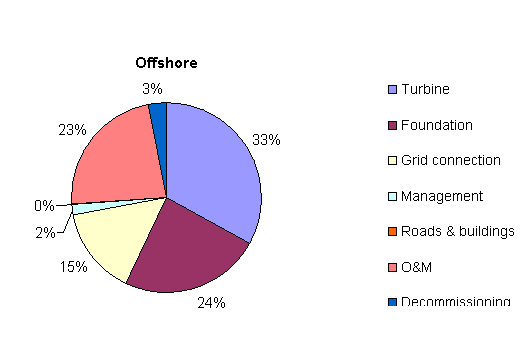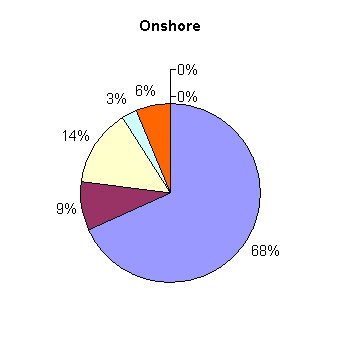
Offshore projects require initially high investment due to turbine support structures and grid connection. Hence large multi-megawatt projects are likely to be the most cost effective. Additionally high reliability, optimum investment and operation costs spread over the lifetime of a project will improve offshore prospects (Wind Developments, 1999). The cost of grid connection to the shore is typically around 25% (Hartnell and Milborrow, 2000) a much higher fraction than for connection of onshore projects. Other sources of additional cost include foundations (up to 30%), operation and maintenance (with expected lower availability) and marinisation of turbines (Hartnell and Milborrow, 2000). Costs of installation onshore have been reduced from about 2200 /kWh for the first Danish offshore wind farms to an estimated cost of 1650 /kWH (Energistyrelsen, 1997) for Horns Rev giving an estimated cost of 4.9 cents/kWh to 1990 /kWH for Ijmuiden giving an estimated energy cost of 6.4 cents/kWh. This compares with typical figures for onshore sites of investment 700-1000 /kWh and estimated energy cost of 3-8 cents/kWh for a mean wind speed of 5-10 m/s. This assumes the energy cost is distributed over 20% with a 5% discount rate (Wind Developments, 1999). Costs have been falling steadily and are estimated to be between 4.4 cents/kWh for a mean wind speed of 9.0 m/s at hub-height to 5.1 cents/kWh for a mean wind speed of 8.4 m/s (Cockerill et al., 1998). Projected costs are downwards as the industry determines less expensive methods for installation and maintenance using experience gained in the offshore industry and at the first offshore wind farms and larger project and turbine size also reduces costs per installed MW.
The UK DTI gives target costs of 750 /kW installed by 2010 which is the upper limit of current onshore costs and operation and maintenance costs of 1p/kWh (just over current onshore costs). They also suggest 95% availability as the target compared with current onshore availability of over 98% (Fletcher, 2001). For specific projects (Hartnell and Milborrow, 2000) give a range of 1466-2050 /kW installed giving a cost of production of 4.7-6.8 4.4 cents/kWh. Operation and maintenance charges are variable according to site but a rough estimate is an annual charge of 30/kW with 0.5 cents/kWh variable (Hartnell and Milborrow, 2000).
Figure 3-3 gives examples of planned offshore installation costs by component. Other models exist e.g. (Hartnell and Milborrow, 2000) suggest 51% for turbines, 18% for grid connections, 16% for foundations, 7% for electrical, 4% for planning and 2% for operation and maintenance facilities. (Kuhn et al., 1998) give cost breakdown for initial costs:
Turbine 45%
Support structure 25%
OWEC installation 7%
Power collection 13%
Transmission 8%
Management 2%
Contributions to energy costs are given in Figure 3.3.
These vary slightly compared with those from (DEA/CADDET, 2000) which are given in Table 8. Investment costs onshore are approximately 1.5 million/MW compared with onshore costs of approximately 1 million/MW.
|
Table 8. Investment costs by component |
||
|
|
Onshore (%) |
Large offshore (%) |
|
Foundations |
5.5 |
16 |
|
Turbines |
71 |
51 |
|
Internal electrical grid |
6.5 |
5 |
|
Electrical system |
0 |
2 |
|
Grid connection |
7.5 |
18 |
|
O&M facilities |
0 |
2 |
|
Engineering and administration |
2.5 |
4 |
|
Miscellaneous |
7 |
2 |
|
Total |
100 |
100 |
The most complete cost analysis to date is (Kuhn et al., 1998) who suggest that the most important parameters are the distance to shore and the annual mean wind speed and provide maps of mean energy cost combining these parameters within a GIS database. Optimal costs are found by balancing these factors.
Forecasting wind energy also provides important advantages in term of increasing the penetration of wind energy and obtaining the best market price e.g. (Giebel, 2001), (Landberg, 1993).
Finally probably the most important development relates to market liberalisation which may jeopardise development at some sites. Guaranteed markets for large offshore wind energy developments may become extinct leaving private developers with capital intensive projects in a market within which the benefits of offshore wind energy are not cost-weighted. Despite the average cost of offshore wind energy being competitive with many traditional energy sources, projects may not be viable if the energy produced cannot be sold on the market at a reasonable rate at the time of production. This may leave Europe in the curious position of possessing an abundant environmentally friendly energy resource whose exploitation enjoys a high degree of public and governmental support but without the market framework which can support its development.
 |

Figure 3-3. Examples of different component contributions to cost for on- and offshore wind farms